#Dragonlance Modules
Text

Hmmm… I might have overdone it over the years with collecting D&D… what do you think?
#dungeons and dragons#dungeons dragons#dnd#rpg#fantasy#high fantasy#sword and sorcery#D&D books#dragon magazine#dungeon magazine#Dragonlance Modules#Forgotten Realms Modules#world of greyhawk
4 notes
·
View notes
Photo

Advanced Dungeons & Dragons: Dragonlance - New Beginnings Adventure Module Cover Art by Jeff Easley
#Dungeons and Dragons#Dungeons & Dragons#D&D#Advanced Dungeons & Dragons#AD&D#Dragonlance#New Beginnings#Adventure Module#Fantasy#Art#Covers#Cover Art#Jeff Easley
133 notes
·
View notes
Text
something something wanna make a rendition of the Ansalon map from Dragonlance cuz I'm reading through the lore and I'm VIBING
0 notes
Text



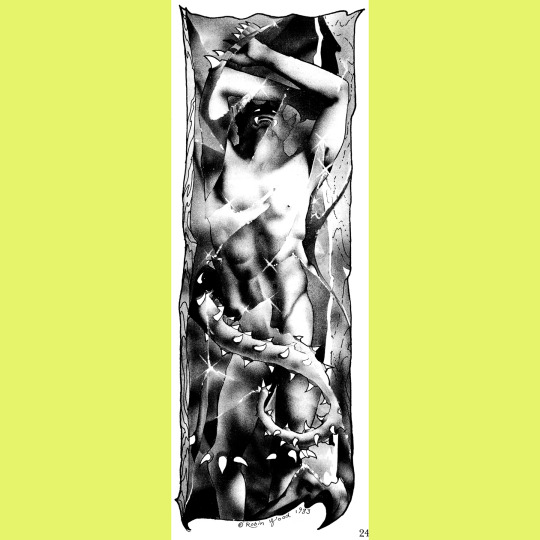
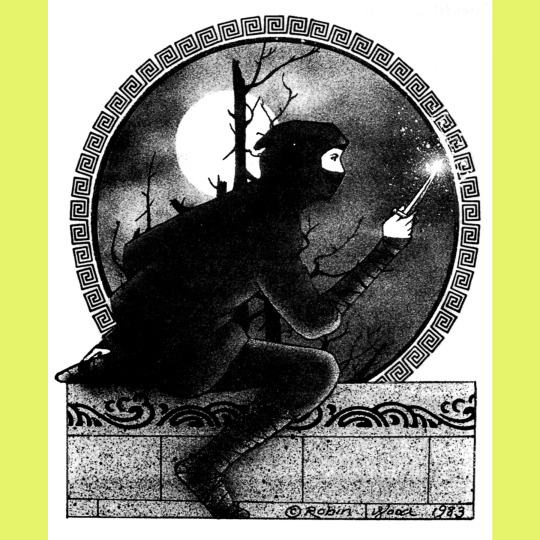

We did a whole episode of the podcast on Swordthrust (1984) last year. That probably tells you something about the adventure’s place in the line. If not, I’ll say it directly: this is probably Role Aids at its weirdest, most experimental and, consequently, at its best.
In short: a titan sleeps atop a high mountain. The party goes in the titan’s ear and explores his brain, looking for a powerful artifact that is calling to them. Inside, there are monsters that have taken up residence, angelic creatures that are manifestations of the titan’s better nature, reptilians that embody his baser impulses, and strange apparitions that are, essentially, his dreams and memories made flesh, making for a very odd variety of environments inside what is supposed to be a complex of ice caves.
All of this is super interesting, especially for the year it was released (compare this to any give Dragonlance module, for instance). It doesn’t go as hard or as bizarre as it could, but that’s OK — it paved the way for plenty of others to get weird (Silent Titans sprints immediately to mind) and leaves plenty of room for the GM to odd it up.
Cover art is another recycled Boris Vallejo, though in this case, the authors incorporated the scene in the adventure — there, this guy is one of the Titan’s dreams who left the brain to live on the mountain and has, essentially, become real. He’s an interesting chap. Interiors are by Robin Wood. She did a lot of Role Aids work and it’s rather variable — I think she was using it as an opportunity to experiment with different styles. These drawings are pretty solid!
113 notes
·
View notes
Text
D&D is pretty good at what it does
But a lot of people want something completely different out of it
How's that for an eye-catching and not at all combative title?
I'm going to preface this post by saying that I do not dislike D&D (any edition of it). I am critical of the game's reliance on tropes that are Fucked Up, it's sometimes incoherent design that emerges from lack of explicit design goals, as well as a player culture that clearly thinks the game is something it is very much not. This point of view is informed by having played D&D (various editions) for more than twenty years and having seen the game struggle with certain types of narratives that oddly enough are the exact types of narratives that people time and time again want to use it for.
This is going to be a hell of a long one so I'm going to put a read more break here. I will have to break this post into multiple posts, so suffice to say that this is just the introduction. Uh, I'll be tagging these as #the big damn post. This is part 1,
Part 1: Terminologie
First of all, a bit of terminology: I have, in the past, used the term challenge game a lot. With that term I refer to a type of role-playing game structure where the GM presents a series of challenges for the players that the players then overcome by interfacing with the fiction through their characters. Challenge games at their core are very much tests of player system mastery, both in how good they are at the character creation minigame but also of how good they are at applying the mechanics of the game in action. Knowing how to make a character who deals a lot of damage when they attack is one test of system mastery, but knowing when it's best to make an attack and against whom is another test of system mastery.
D&D, old-school, is very much a challenge game. Within the context of D&D, the dungeon crawl has been the purest expression of a challenge game.
But most D&D players don't play D&D as a pure challenge game. As early as AD&D 1e there were already modules that presented adventures that were more grandiose than the traditional dungeon crawl. I don't feel comfortable placing the blame for this squarely on Dragonlance, but the early Dragonlance modules definitely helped popularize this type of adventure and AD&D 2e finally cemented it into the game. The fact that the 2e DMG doesn't even have a procedure for creating dungeons is telling of this.
And it has been so ever since: even D&D 3e which presented itself as a return to the dungeon type of affair still presented those dungeon crawl scenarios within the framework of an extended, grander narrative, as did 4e. This structure of using D&D to tell longer, extended narratives that are more than simply player-driven explorations of a funhouse setting built by the DM has also become very popular over the recent years, largely due to the prevalence of actual play media that presents these types of extended narratives powered by D&D gameplay.
Now, I don't have a definition ready for the latter type of gameplay. "Story game" and "narrative game" don't sit right with me because those terms mean very different things to me, and to me D&D played with the express purpose of authoring a collaborative story together still plays very differently from what I consider a story game. I thus think it's better to talk about modes, like different modes in a video game. Specifically, there's Story Mode and Challenge Mode. And most groups actually end up playing a game which switches between the two modes.
So, D&D: Challenge Mode refers to D&D played purely as a game that challenges players on their system mastery where they interact with a fictional place or situation with the purpose of simply overcoming the challenges placed there by the DM, pretty much exclusively with the goal of growing in power and thus being able to overcome greater challenges. The purest expression of a challenge game is a dungeon crawl or sandbox game, as these structures also allow for player agency in determining which challenges they wish to engage with and how, thus allowing for another expression of system mastery. It should also be noted that a challenge game is not necessarily a purely combat-centric meat grinder, as there can be social challenges placed even within the context of a dungeon crawl and how to overcome those challenges can also be an expression of system mastery.
On the other hand, D&D: Story Mode refers to D&D played with the goal of experiencing a grander narrative with greater stakes that are either of import to the world or personal to the player characters. The "story" can either be a DM authored linear narrative that the players are expected to follow, their characters basically taking the role of the protagonists in that story, but Story Mode does not automatically rule out emergent narratives or player agency.
As stated before, most players actually end up playing a mix of the two modes, because D&D is at its core a challenge game so by its very structure players will end up engaging with Challenge Mode. Very few players play the game as a pure challenge game these days, in part because that playstyle is considered a lesser expression of the game.
And that's the thing: even though the expected playstyle of D&D has changed over the years to favor Story Mode, the game of D&D has changed very little structurally to the point where it's still very much a challenge game. Even in the strictest Story Mode game players will still be engaging with what is, ultimately, a challenge game engine.
Next time I will be talking about what it is that D&D does by its mechanics and what it is about it that makes it structurally a challenge game. In later instalments I will go more in depth into what it is about this structure that makes it very bad for Story Mode games. I will also try to provide some solutions, although fair warning: a lot of my advice is going to boil down to "play a different game if you want Story Mode" or "accept that D&D works best at Challenge Mode and play it like that."
162 notes
·
View notes
Text

Cover art for the D&D Fanmade manual “Autumn Twilight” by the “Dragonlance Nexus”: a conversion from AD&D to D&D 5th edition of the original game module. Coming soon on DMGuild. This painting was commissioned by the Dragonlance Nexus: a fanart about the very beginning of Dragons of Autumn Twilight by Margaret Weis and Tracy Hickman: Tanis Helf-Elven, Tasslehoff Burrfoot, and Flint are about to return to the Inn of the Last Home in Solace.Of course, the rock under the tree on the right, near Flint, is “that” rock. Fans will know.
Work in progress and more information on my website: https://greenedera.com/portfolio/solace-dragonlance-nexus/
Created on: 08/05/2022
Copyright 2022 Elena Greenedera Zambelli, all rights reserved #noai
#dragonlance#dragonlance fanart#fanart#digital painting#support human artists#noai#tanis half-elven#kender#tasslehoff#flint fireforge#solace
100 notes
·
View notes
Text
How the Drow Became Problematic Faves - a Badly Written Meta History of D&D
Oh, hey. It feels like newcomers to D&D via BG3 fandom have discovered the Problematic Nature of Drow via Halsin vs Minthara conflict.
Cut because of talk of racism and it being fucking long.
Let's talk about meta, first. So, the very first usage of 'drow' came from a dialetc of Scots as a term for troll, which was used to talk about all sorts of evil spirits. When Gary Gygax had to make a war game, he decided he'd make evil elves. They were based on 'black elves' in the Prose Edda and saw the word 'Drow' in a dictionary that claimed it was a term for underground elves who were skilled workers in metal. Being a white guy in the late 70s, he saw no issues in making evil elves actually black. For the next decade or so, they were canon fodder for modules and novels and always evil and repugnant.
In the late 80s and early 90s, R. A. Salavotre and Ed Greenwood slapped on the concept of drow society being an evil dystopian society run by dominatrixes who emasculate men, in the Forgotten Realms setting. There were a few token dark elves, namely the super popular Drizzt Do'Urden, who were good but the majority were not. Like Gary, RA and Ed were white guys who did not see the problem of black elves and putting their kink into deep lore. Not all settings went by this, Dragonlance for example had drow just be ‘evil assholes elves who got kicked out of their society’ and look like just any other elves.
(Quick note on Drizzt, he became iconic not because of his race but so much as being an outsider to two cultures while being a badass. I might not be a fan personally, but I know the appeal of the character.)
The 90s came along and by the end of the decade, TSR was bought by Wizards of he Coast who proceeded to make the Drow even Grim Darker during 3rd edition to go along with the times. Yet, too, didn’t stop to think about the problematic issues that were being brought up by more thoughtful fans - WotC hired another module company who wrote about drow women being so fucking evil, they an orgasm like reaction when embryo killed each other in the womb.
4th Edition came and went. No one talks about those times. Drow existed as evil.
2014, 5e comes along and drow are so fucking popular, they’re included in the Player’s Handbook, rather in errata based books, as ‘humanoid’. In fact other evil races were introduced under the label of ‘humanoid’, indicating orcs and goblinkin. About a year later, Matt Mercer switched up his TTRPG to 5e because it was an easier system for his friends to understand, and they began to show their games online under Critical Role while a year after that Stranger Things came out and became a smash hit.
Between these two, D&D explodes in popularity with an entirely new demographic group that began to outnumber the old guard. This larger and more diverse popular saw drow and other ‘evil races’ and went ‘wtf’. They didn’t exactly like the concept of ‘an always evil race’ and discovered the problematic issues that collected over the last several decades not with just drow, but with ‘monstrous’ races.
WotC wanting money began to listen - just really slowly, and not so much in Forgotten Realms.They dropped the ‘always evil’ from the stat block but refused to change anything else to their older settings.
(Incidentally, the company that made Grim Dark Drow really disliked 4e. They decided to make their own take of 3.5e with Hookers and Blackjack and made Pathfinder, which was supposed to be Edgier Game than D&D. However, a lot of people they hired were quick to notice the nature of the game and say, ‘nah, this shit is stupid’. As of now, Pazio is retconning drow from their lore. - That my friends, is called a character arc.)
During this 46 year span, drow have been fucking evil because their goddess made them do it as justification of their evilness - and not because they were black or born into it. In fact, Lloth, Gruumsh and Maglubiyet are the reasons why the Drow, Orc, and Goblinkin society is so evil and they’re also why they can function as a society when in truth, they all should have fallen apart. And no one has bothered to change this lore. In fact they avoid mentioning this lore rather than changing it to avoid conflict with older fans and newer fans.
Then BG3 hits and hits harder than anyone expected. A lot of new fans come on aboard and really begin to like Drow, who are super sexy evil elves, not knowing the lore and kicking the problematic issues down the road. Larian was a bit quicker than TSR/WotC to realize ‘wow, this is fucking yikes’ and decided to make Seldarine drow. I’ve been playing since I was young teen, in the last years of 3.xe. I saw a lot of wanna-be Drizzt and Good Aligned Drow that were played variably, but there were a lot of people who loved the concept. While Seldarine aren’t a concept in TTRPG canon proper, the idea of Seldarine drow has existed for decades at tables, and Larian acknowledging that is something I love.
But they made Llothsworn Drow as the ‘lore compliant drow’ because WotC hasn’t changed drow in decades.
The thing is, Drow being Problematic Faves isn’t because WotC is wildly racist on purpose, it’s just that during the majority of Drow being A Thing in D&D, they have been Sexy and Evil Villains and play the role of Misunderstood Outsider (though this recently has been taken over by tieflings).
In fact, I’m seeing a lot of new fans getting kicked in the teeth when characters react to a Llothsworn drow as flat out evil and not being judged by their actions, because they don’t know it’s been a thing in D&D for years with narrative excuses to justify in-universe racism. And then there are some players who make an evil Llothsworn drow and still get upset despite playing into in-universe reasons for the excuses of racism.
We’re seeing it as a reaction to datamined information with little context other than an abused white guy feels uncomfortable with an abused black woman - and it’s super hard to justify in-universe reasons for this because in the real world, a white guy is going to be listened to and believed regardless of it being true or not.
Essentially, the drow are a fucking mess due to D&D ignoring the racial implications of drow in the real world for nearly 50 years. The only way to fix it is making major lore changes, which is something they’re reluctant to do because they’re making their errata books so damn light on lore as to avoid conflict and the model sells.
Will this change with BG3? I don’t know. But I kinda hope so.
56 notes
·
View notes
Text
446. Douglas Niles and Tracy Hickman - DL11: Dragons of Glory (1986)
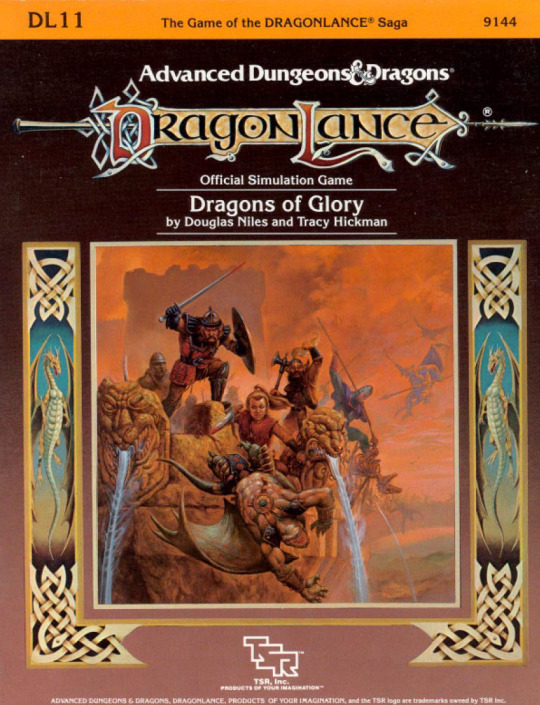
A unique addition to the Dragonlance series of modules, this eleventh entry in the series is not really a continuation of the adventure of our gang of mismatched heroes but a parallel board game. Similarly to the recent fifth edition "Warriors of Krynn" board game that was supposed to be played in conjunction with the Shadow of the Dragon Queen campaign, this entry is actually a board game that is supposed to determine how the wider War of the Lance is going.

It's interesting that we would get this game in parallel to the already existing Battlesystem wargame, but Dragons of Glory is supposed to determine the war at an even larger scale, at the scale of the whole continent, with players moving whole armies around the map instead of being a skirmish battle.
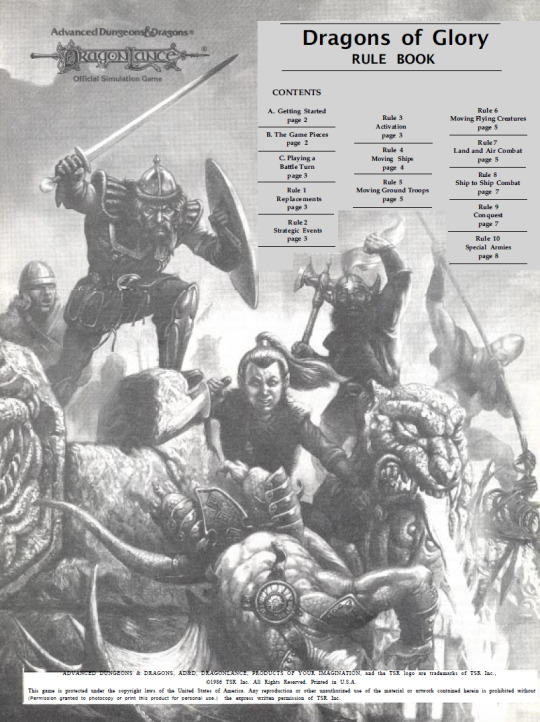
In fact you could play Dragonlance at three levels, the micro level of the roleplaying adventure, a middle level of Battlesystem local battles and a macro level where you would use this game to determine positions of whole armies and war advancement across the continent of Ansalon. If, for example, your roleplaying party happens to be in some location where this game determines there is an active Dragon Army, this should then influence the micro roleplaying action. For this reason you get a massive map and a load of counters bundled with this set as well as rules for this board game. Not sure if anyone actually used this as it seems hard to manage as well as demanding that you get your friends together for yet another game!

#adnd#dnd#ttrpg#ad&d#d&d#dnd art#dungeons and dragons#dungeons & dragons#dragonlance#tracy hickman#douglas niles
23 notes
·
View notes
Text
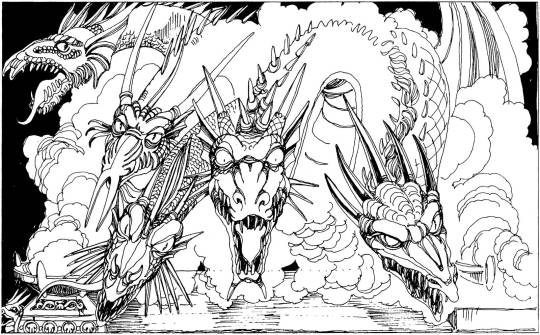
Takhisis in the Temple of Darkness (Diana Magnuson, AD&D Dragonlance module DL14: Dragons of Triumph by Douglas Niles, TSR, 1986) This borrows elements from Clyde Caldwell's painting that was used on the cover of this module, which also was referenced in the opening credits of Record of Lodoss War.
#D&D#Dungeons & Dragons#Diana Magnuson#dragon#Dragonlance#Takhisis#Tiamat#AD&D#Dragons of Triumph#dnd#1980s#Dungeons and Dragons#The Temple of Darkness#brazier#TSR
172 notes
·
View notes
Text

Clyde Caldwell “Dragon of Triumph” (1984) original Dragonlance module cover illustration
Source
36 notes
·
View notes
Text
a party: *ongoing*
me, laying on the floor with my arm over my eyes and a small circle of disciples gathering: Dragonlance is a Dungeons and Dragons setting conceived in the 1980s that enjoyed a multi-pronged marketing approach, with TSR releasing both a series of novels and a series of adventure modules that were intended to let groups of players roleplay as the story’s iconic characters and experience the important plot points for themselves. (Actually putting such pre-scripted material into play had very mixed results, but a lot of people do fondly remember this.)
The foundation of the Dragonlance canon is a trio of novels referred to as the “Chronicles” which follows the adventures of a party of characters on a quest to free their world from the armies of the evil goddess Takhisis. There are dozens of other books by various authors, but the primary writers are Tracy Hickman and Margaret Weiss, who met while working for TSR.
Dragonlance is highly nostalgic for many people and has many memorable characters and enjoyable moments, but there is one small problem with it:
It’s not good.
If you will permit me to elaborate, I-
21 notes
·
View notes
Text
Gotta scream about my DnD campaign for a minute. Vague spoilers for Dragonlance: Shadow of the Dragon Queen below.
So I normally have pretty strong ideas about my character’s backstories, and I don’t want to feel like I’m pawning off work on my DM, so I usually turn in a one page summary of my character’s experiences to that point, to the best of my knowledge. Most in-person long-term campaigns I’ve been in have been modules without a ton of wiggle room, so I haven’t tried to put much mystery or focus on my character’s past.
However.
One DM in my regular in-person friend DnD group offered to run the new Dragonlance campaign, starting this summer. I had a human polearm fighter concept that I’ve been toying with for years, and this felt like the perfect time to try her out.
Now, I knew she had battle related trauma, and I had a vague idea of her having been trapped behind enemy lines or captured or something. But I know nothing about Dragonlance. I read the lore chapters our DM sent, but wasn’t much there to dictate what sort of skirmishes and scrapes my knight would have been a part of.
So I brought it to my DM. I gave him what I thought the important emotional beats would have been. 1) Traumatizing 2) Handled badly by an authority figure 3) My character rose to the occasion and saved lives 4) She’s still ashamed and feels like a failure more than a hero.
What my DM gave me back was… not what I had pictured. There were ghosts and undead and possession, and I had envisioned something much more mundane, not so dramatic. But it absolutely filled every qualification I had sent. I figured maybe it was a story from one of the Dragonlance novels, and decided to embrace it, build more of my character around it.
I never figured it would come up in the campaign, except in the way I played my character.
Then, four or five sessions in, the ghosts from my character’s past rode by our party’s campsite on a rainy night.
And of course my character panicked and backstory came out to the party and it was a great, dramatic moment.
And I thought, wow, how cool of the DM to give my character that opportunity. That’s probably it.
Nope.
Last session, the main antagonist from my character’s backstory—the ghost that possessed her commander, that chased her over miles as she fled with a handful of other soldiers—came into the story in a big way.
Turns out, he’s a major enemy NPC of the campaign.
He fought our party. He possessed my character. The rest of the party had to KO her as he made her attack them. He got away to fight another day.
My character is WRECKED.
It was amazing.
It was so much more than I could’ve hoped for.
So yeah. If you have a good DM, one you trust (and I hope you do) give them parts of your story! Not just the parts that your character wouldn’t know, but parts that they can incorporate into a world and a story they know better than you. I’ve never had more fun playing DnD, or been more deeply impacted.
Maybe this isn’t as revelatory for others, but man, it’s been a literal game changer for me.
#dnd#oc#badge kallas#because her commander was left behind the ghosty guy knows things about my character too#badge is a nickname and this creep comes in calling her given name#which only her family uses#man it was so creepy#man our dm is really going all out with this campaign
9 notes
·
View notes
Photo

DL4: Dragons of Desolation Cover Art by Keith Parkinson
#Advanced Dungeons & Dragons#AD&D#Dungeons and Dragons#Dungeons & Dragons#D&D#Dragonlance#Adventure Module#Dragons of Desolation#Covers#Cover Art#Flying Citadel#Keith Parkinson#Fantasy#Art
117 notes
·
View notes
Text
Food for thought...
I’s like to point out that I think someone needs to educate authors Margaret Weis and Tracy Hickman on a person’s healthy body weight when it comes to Raistlin Majere from Dragonlance.
According to his stats on page 22 of the 1984 D&D Module: DL 5-Dragons of Mystery, he’s 5′9″ weighing in at 135 pounds. They repeatedly hammer home how sickly, frail, and skeletal he his throughout the books like he’s something abhorrent to look at.
Well, according to the National Heart, Lung and Blood Institute’s BMI chart, our buddy Raistlin comes in at a 19.9 on the scale. On the lowish end of normal...
This leaves me to wonder how people viewed skinny people in the 80s with so many macho man bulgy muscle flicks like Conan the Barbarian and the like...
Anyway, images as proof:


#dragonlance#raistlin#raistlin majere#healthy BMI#the dude is in the normal range leave him alone#these are the things that keep me up at night#I just thought I'd share
22 notes
·
View notes
Text

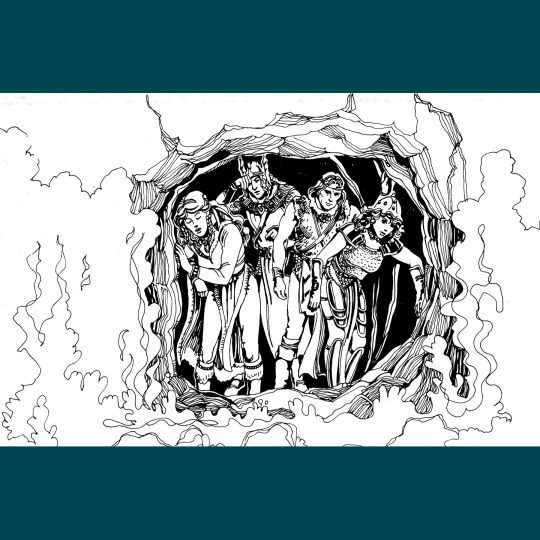

I’ve long been vexed by this cover painting by Jeff Easley (annoyingly, it is credited to Caldwell inside). It appears in the Art of Dragonlance and I could never parse it because it doesn’t line up with anything in the books, really. It lines up slightly with some stuff in here, and in the next adventure, but it still ultimately remains enigmatic for me. Perhaps entirely because I think the constellation watcher is supposed to be Paladine, but I can’t parse it as anything but “glowing tree man.” I dunno man, Dragonlance does weird things to my brain.
Anyway. DL13: Dragons of Truth (1986). Hickman’s last writing gig in the series. It amounts to exactly what it is, the thirteenth episode of a fourteen episode series. It’s all set-up. It tries hard to be clever, and often succeeds! But it is, nevertheless, set-up.
Basically, the players go to Paladine’s house to be tested. If they pass the test, they get the answer to some very big questions and an idea of how to defeat the dragon queen in the next module. The module uses the tarot cards to randomize the three potential tests and six different plot outcomes. Is Fizban actually Paladine? What’s the deal with the weirdo with the gem in his chest? And where is Huma? Pull a card and find out! Part of me feels like I should complain about this not being weighty or something, but I rather like it, honestly. Its a good way to randomize the end game of the modules (only one outcome exactly matches the novel, but I feel like at least three kinda sorta match the novel?).
I dunno. Sometimes the set-up is the best part? This is maybe my favorite of the DL-series? It’s all anticipation, it hangs together well and you don’t have to worry about resolutions, which almost always disappoint. It’s a module about possibilities. That’s cool, especially in a series that has been so choreographed to this point.
57 notes
·
View notes
Text
The oldest big fandom brawl I can clearly remember in the internet age would have to be in the alt.fan.dragonlance USENET group, in 1992, after the release of the Tales of the Lance boxed set. I don’t think people quite understand how ferociously passionate people used to get about their favorite AD&D settings.
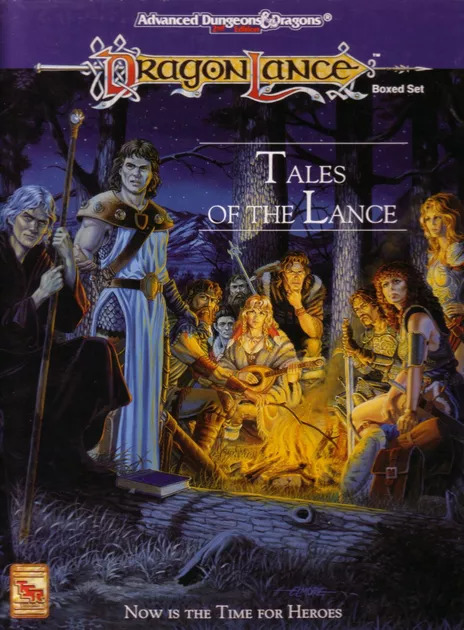
Some context: Dragonlance was unique in that it was an AD&D setting that never got an official boxed set where everything was all set down in a definitive fashion until a full decade after it started publication. Remember, the world was introduced through a series of adventure modules, followed by tie-in novels that were a hit. Tales of the Lance in 1992 was going to be the big setting box. There’s more, though. The Tales of the Lance boxed set was extra contentious because the original creators of Dragonlance (Hickman and Weis) were forced out because of all kinds of backstage machinations. In other worlds, there was an aura of cold, ruthless commerce and illegitimacy about it all, from an organization that already ousted Gary Gygax from his own company only a half decade before. TSR was also hyper invested into Buck Rogers XXVC, which nobody liked but which existed to be a borderline illegal money pipeline out of TSR (sufficed to say, we are leaving the world of fandom complaint, and entering the world of white collar crime). In other words, the fanbase had some trust issues with TSR.
So, when Tales of the Lance came out in 1992, which not only set down in stone a world that already existed in everybody’s heads for a decade, but was also defined by a vision that wasn’t the original creators’, put out by a company the fandom didn’t trust...well, there were bound to be problems, and the reaction was disproportionate. Honestly, most of the critiques of Tales of the Lance sounded like the ultimate in nerd nitpicking, back when fandoms were way less concerned with ‘ships and way, way more right-brained (though even then, people loved to speculate if Tanis Half-Elf was gay or bisexual). An example of the kind of mistake they brought up was that the boxed set said all Silvanestri elves have hazel eyes, when probably the intent was that was just the line of Silvanost. Yeah, okay, that’s just the telephone game in operation, but...does it matter that much? But in 1992, AD&D fans were really willing to fight over very, very minor things like that, that’s how real all this was in people’s heads.
232 notes
·
View notes